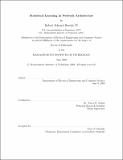| dc.contributor.advisor | Karen R. Sollins. | en_US |
| dc.contributor.author | Beverly, Robert E., 1975- | en_US |
| dc.contributor.other | Massachusetts Institute of Technology. Dept. of Electrical Engineering and Computer Science. | en_US |
| dc.date.accessioned | 2009-01-26T22:01:51Z | |
| dc.date.available | 2009-01-26T22:01:51Z | |
| dc.date.copyright | 2008 | en_US |
| dc.date.issued | 2008 | en_US |
| dc.identifier.uri | http://hdl.handle.net/1721.1/44210 | |
| dc.description | Thesis (Ph. D.)--Massachusetts Institute of Technology, Dept. of Electrical Engineering and Computer Science, 2008. | en_US |
| dc.description | This electronic version was submitted by the student author. The certified thesis is available in the Institute Archives and Special Collections. | en_US |
| dc.description | Includes bibliographical references (p. 167-[177]). | en_US |
| dc.description.abstract | The Internet has become a ubiquitous substrate for communication in all parts of society. However, many original assumptions underlying its design are changing. Amid problems of scale, complexity, trust and security, the modern Internet accommodates increasingly critical services. Operators face a security arms race while balancing policy constraints, network demands and commercial relationships. This thesis espouses learning to embrace the Internet's inherent complexity, address diverse problems and provide a component of the network's continued evolution. Malicious nodes, cooperative competition and lack of instrumentation on the Internet imply an environment with partial information. Learning is thus an attractive and principled means to ensure generality and reconcile noisy, missing or conflicting data. We use learning to capitalize on under-utilized information and infer behavior more reliably, and on faster time-scales, than humans with only local perspective. Yet the intrinsic dynamic and distributed nature of networks presents interesting challenges to learning. In pursuit of viable solutions to several real-world Internet performance and security problems, we apply statistical learning methods as well as develop new, network-specific algorithms as a step toward overcoming these challenges. Throughout, we reconcile including intelligence at different points in the network with the end-to-end arguments. We first consider learning as an end-node optimization for efficient peer-to-peer overlay neighbor selection and agent-centric latency prediction. We then turn to security and use learning to exploit fundamental weaknesses in malicious traffic streams. Our method is both adaptable and not easily subvertible. Next, we show that certain security and optimization problems require collaboration, global scope and broad views. | en_US |
| dc.description.abstract | (cont.) We employ ensembles of weak classifiers within the network core to mitigate IP source address forgery attacks, thereby removing incentive and coordination issues surrounding existing practice. Finally, we argue for learning within the routing plane as a means to directly optimize and balance provider and user objectives. This thesis thus serves first to validate the potential for using learning methods to address several distinct problems on the Internet and second to illuminate design principles in building such intelligent systems in network architecture. | en_US |
| dc.description.statementofresponsibility | by Robert Edward Beverly, IV. | en_US |
| dc.format.extent | 175, [2] p. | en_US |
| dc.language.iso | eng | en_US |
| dc.publisher | Massachusetts Institute of Technology | en_US |
| dc.rights | M.I.T. theses are protected by
copyright. They may be viewed from this source for any purpose, but
reproduction or distribution in any format is prohibited without written
permission. See provided URL for inquiries about permission. | en_US |
| dc.rights.uri | http://dspace.mit.edu/handle/1721.1/7582 | en_US |
| dc.subject | Electrical Engineering and Computer Science. | en_US |
| dc.title | Statistical learning in network architecture | en_US |
| dc.type | Thesis | en_US |
| dc.description.degree | Ph.D. | en_US |
| dc.contributor.department | Massachusetts Institute of Technology. Department of Electrical Engineering and Computer Science | |
| dc.identifier.oclc | 289324794 | en_US |
